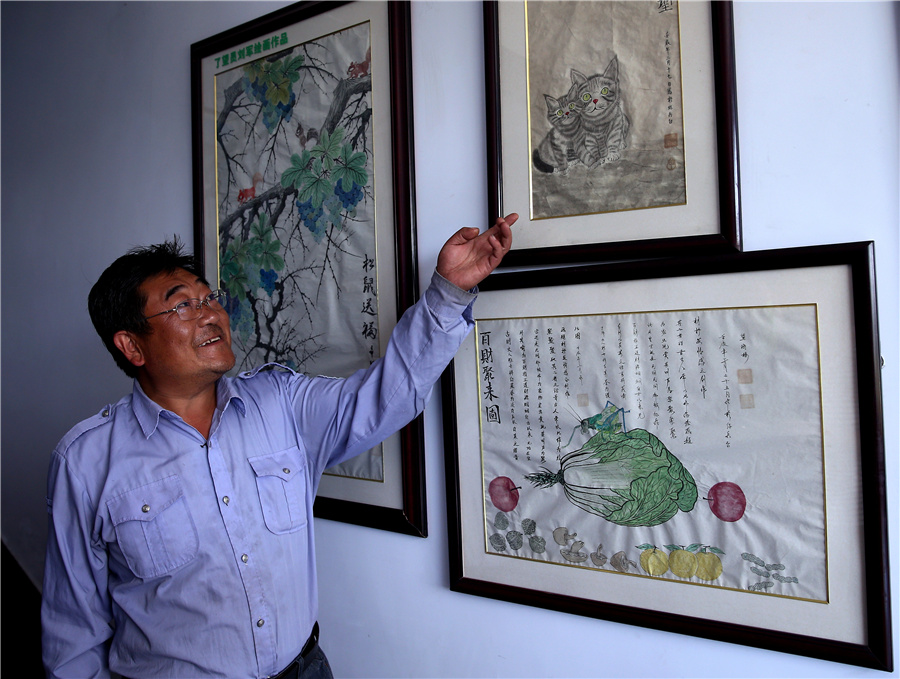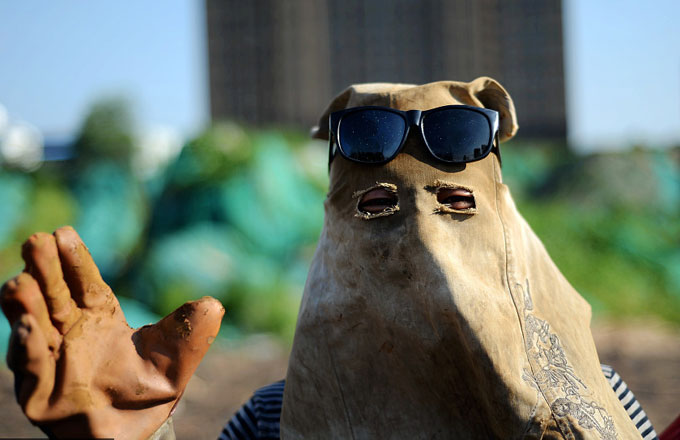How a desert branched out to become Beijing's guardian
 |
|
Liu Jun displays some of his paintings at his watchtower.[Photo by Zou hong/China Daily] |
He found a solution to loneliness through his wife, Qi Shuyan.
Qi always refers to Liu as her big brother. "Love is better preserved here," she said, her giggles drawing a broad smile from her taciturn spouse.
"It can be extremely boring, but boredom shared by two is boredom halved," she said. However, boredom halved is still boredom. That's why she has devoted herself to embroidery over the past few years, while Liu paints.
"I started painting in 2009, four years after I came here. All my earliest works were painted on the paper we used to cover the slim openings between window panes in winter," he said. "I never expected them to last."
Some of his paintings adorn the interior walls of the couple's watchtower, including the ground-floor bedroom. One particularly eyecatching work depicts a couple of cats snuggling up to each other, both looking into the distance.
If isolation has become bearable for couples-of the nine watchtowers, eight are occupied by husband-and-wife teams-it also proved damaging for their children, who often felt deserted without their parents.
"During the fire-prone seasons of spring and autumn, my wife and I stay at the tower for three consecutive months without seeing our son," he said.
The boy was brought up by his grandparents, but when he was 12, he tried to kill himself by drinking an analgesic potion intended for exterior use.
"I heard the news and headed home, which at the time was two hours' drive away. Mid-journey, I was told that my son was safe and his condition wasn't serious, so I headed back," Liu said, before plunging into a long silence.
His son, now 24 and healthy, joins the forest's firefighting team twice a year, during spring and autumn.
His parents are as busy as ever: During the fire-prone seasons, they are required to report to the forest's fire-control center regularly, especially at night.
"My wife and I have an arrangement: I sleep for the first half of the night, while she does the second half," said Liu, who has reported several small fires, including one in the neighboring Inner Mongolia autonomous region.
"There has not been a major fire in the past 55 years, which is a miracle for a forest located in a dry, cold place. From where I stand, I can recognize every single creek and crevice on the mountains, and of course every plume of smoke that is neither mist nor a dust storm," he added. "These days, we have all types of advanced fire-detection equipment, including an infrared radar system and a lightning warning system, but nothing can replace me and my binoculars.
"Back in 1962, my parents were the very first two fire watchers. They worked here until the mid-1980s. They must have seen what I'm seeing today. We share a lot more than I had thought."
Liu's father died in 1994 at age 52. Sometimes, Liu and his son sit together in front of his watchtower in silence, facing the greenery. Liu senior prefers to let the rustling trees do his talking for him.
Behind them, hanging vertically on the building are three red Chinese characters, the playful name Liu has given his beloved tower, standing high above the "ocean" of green trees: Wanghailou, or "Sea Watching Tower".













